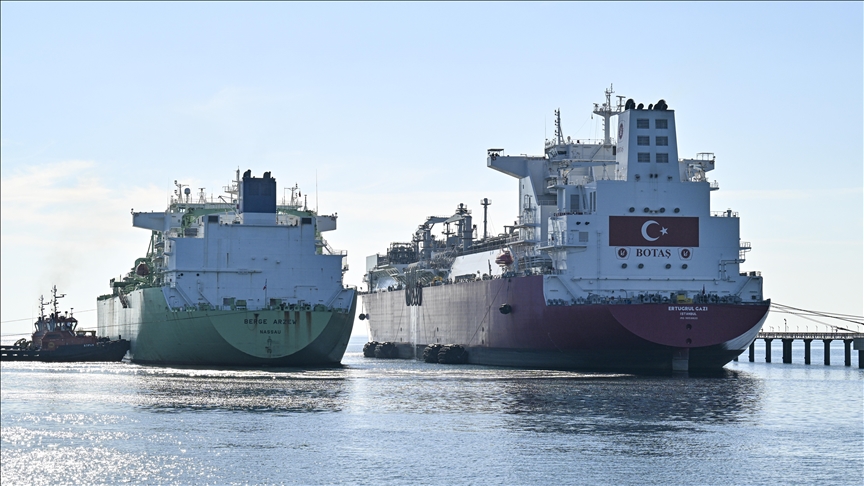

By Anadolu Agency
EDIRNE / HATAY, Türkiye
Türkiye, with three Floating Liquefied Natural Gas (LNG) Storage and Regasification Units (FSRU), ranks third globally in the list of the countries with the most FSRUs.
According to the most recent International Gas Union’s 2023 World LNG Report, Brazil leads the globe with six FSRUs, followed by Indonesia with five, and Germany and Türkiye each with three.
The International Gas Union surmises that there are 43 FSRUs worldwide in 26 countries. Türkiye is one of the few countries in the world that has three of these units, which are crucial to the infrastructure of the nation’s natural gas supply.
With two FSRUs run by Turkish Petroleum Pipeline Corporation (BOTAS) and one by the private sector, operating at maximum capacity, Türkiye is entering the winter season with confidence, knowing that it has enough gas supplies at a time when demand for natural gas peaks.
The fleet of Türkiye’s FSRUs is essential to energy security since, following the regasification process, the ships are utilized to store LNG and pump the gas to the internal system.
The country’s three FSRU terminals are dispersed throughout the country, with one located in Izmir on the west coast, the second in the southernmost city of Hatay, and the most recent addition in Saros along the northeast Aegean Sea. BOTAS operates the last two.
Ertugrul Gazi: the country’s first Turkish-flagged FSRU ship
Ertugrul Gazi FSRU Operations Manager Hakan Boyraci told Anadolu that the Dortyol marine terminal in Hatay plays a crucial role for the country’s gas supplies by operating crude oil pipeline management services since 1967 and FSRU terminal management since Feb. 7, 2018.
The first Turkish-flagged FSRU ship, Ertugrul Gazi, has operated at the Dortyol terminal since June 25, 2021.
Speaking on the procedure of transferring LNG, Boyraci clarified that ships arriving from all over the world visit the terminal where LNG is transferred once the two ships are docked side by side, in accordance with numerous LNG supply agreements that BOTAS has with LNG exporting nations. The LNG transfer takes approximately 48 hours, while the re-gasification process takes about four days.
The country’s second FSRU ship has a total LNG storage capacity of 170,000 cubic meters, equivalent to 110 million standard cubic meters in gas form. It can deliver 28 million cubic meters of gas per day to the main transmission line, and it can be refilled based on the volume of daily re-gasification as needed.
In the two and a half years since the ship has been in use, 49 ship-to-ship LNG transfers have been made, he said.
“During these operations, we stored 4.4 billion standard cubic meters of LNG on our ship and re-gasified approximately 4.3 billion standard cubic meters of the stored LNG.”
He confirmed that the ship is ready for full-capacity winter operations, both in terms of BOTAS acquiring sufficient natural gas supplies and having all the necessary maintenance undertaken for peak natural gas transmission.
The winter season typically sees an increase in transfer operations from one ship per month in the summer to five or six ships monthly over the winter period.
Saros FSRU Terminal: Türkiye’s newest
Türkiye’s newest FSRU facility, Saros FSRU, contributes to the country’s energy supply security, notably in the Marmara region, where major natural gas-consuming cities, including the densely populated Istanbul, are located.
BOTAS’s second FSRU terminal, Saros, which became operational in December 2022, transfers gas to the national transmission system through a 17-kilometer-long pipeline, Ali Kestane, Saros FSRU Operations Manager, said.
The facility contributes to the energy supply security of not only Türkiye but also Europe by allowing flexibility in the system through its daily re-gasification capacity of 28 million cubic meters.
To date, the Saros FSRU has managed a total of 10 ship-to-ship LNG operations, each with a transfer volume of around 160,000 cubic meters of LNG, Kestane said.
Kestane also gave reassurances that the facility is fully prepared for the intensity of the winter period.
We use cookies on our website to give you a better experience, improve performance, and for analytics. For more information, please see our Cookie Policy By clicking “Accept” you agree to our use of cookies.
Read More